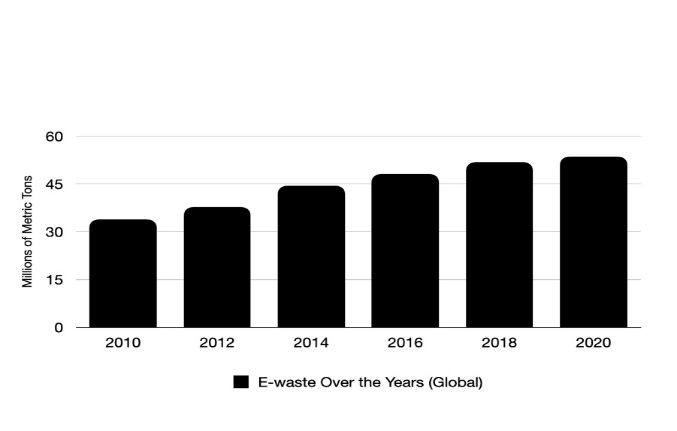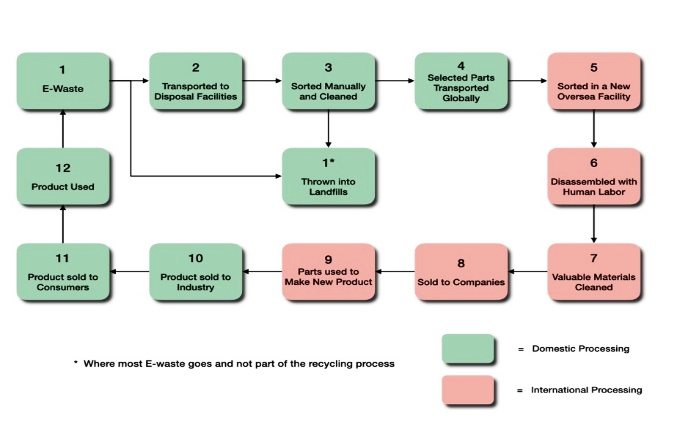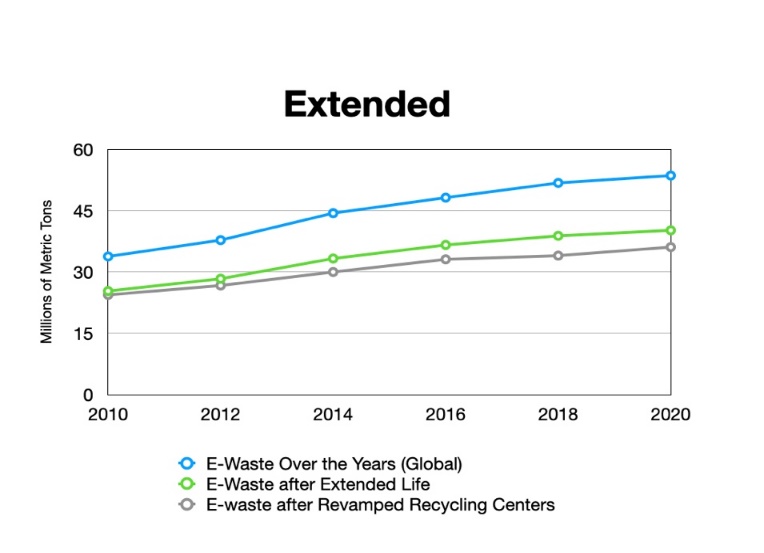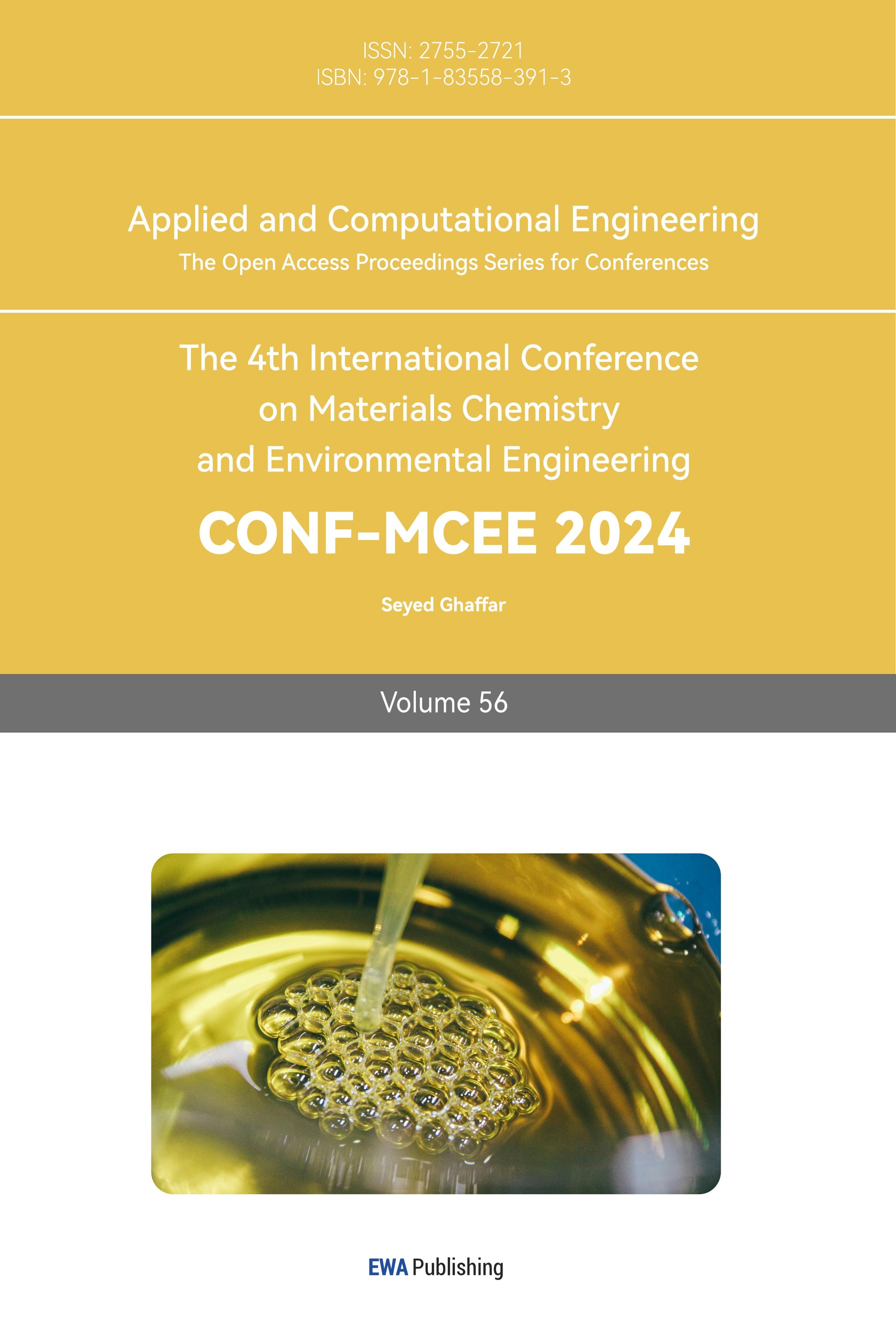1. Introduction
Electronic wastes (or e-wastes) are the electrical devices that could be potentially hazardous and require specific disposal methods. E-waste can range from old cables to phones, refrigerators, cars, and much much more. Each device potentially contains toxic components like mercury, lead, and cadmium, which can leak and destroy the environment if disposed of improperly [1]. As technological demands are on the rise, so have the piles of e-waste, and consequently the environmental impacts of such devices.
For the past decade or so, global e-waste has increased at a constant rate of 2 million metric tons each year [2]. Of the current 56.7 million metric tons of e-waste in the world—around 50 pounds of e-waste per person —only 17.4% of it is actually thrown into recycling centres and disposed of properly [3]. In the US, around 300-400 million devices are thrown away, with only around 20% actually recycled [4]. Around 100 million devices are stowed in drawers and other forgotten areas of a home, taking up space and energy [5]. People hoarding their devices do not use them, but keep them either due to sentimental value or just uncertainty of how to dispose of them. The build up of such waste in both homes and landfills has caused detrimental health impacts on humans, animals, and the globe itself. Throughout the years, global e-waste has steadily increased to become a huge, impending problem, as shown in Figure 1.

Figure 1. Global E-waste over the years [6].
Toxic chemicals that leak out from these devices when compressed in landfills can cause air, soil, and water contamination that infiltrates our lungs, digestive systems, and our environment [7]. E-waste itself releases thousands of harmful toxins and metals into the environment. However, not all e-waste is found alone, and most of the time, chemicals from multiple e-waste sources combine and magnify, causing over pollution of waste and toxicity. There are few set toxicity levels each chemical released has, and when combined, the possibilities are endless. E-waste pollution has led to increases in lung, liver, neural, and endocrine diseases, especially among those who handle them directly [8].
Home appliances, laptops, and smartphones are currently the leading sources of e-waste [9]. With each new model of phone and laptops, companies pile on more devices, leaving more and more—not fully used—devices to pile up in landfills. The cycle starts when past models of phones and computers are all out of date and left alone, either in landfills or home drawers, and as each new model (which requires new resources to be extracted too) comes out, another model is thrown away, forever building on itself. This cycle leaves piles and piles of discarded electronics to decompose but at the risk of leaking toxic chemicals and metals at the expense of the earth. Each year, with growing amounts of updates to smartphones, the amount of waste continues to grow as well. Since cell phones contain more concentrated amounts of toxic metals and the hardware is overall more difficult to deconstruct, disposing of them is especially hard. The growing industry, on top of a much smaller recycling industry, has led to great environmental deficits that we can only hope to repair.
Currently, there is no one solution that is universally accepted and implemented when disposing of e-waste. While each method has its pros and cons, there is still much more work that needs to be done to all the potential solutions to create the best way to treat e-waste. This paper aims to examine the most effective and beneficial solution to quickly deplete the growing e-waste issue, and use data and analysis to back up our decision.
2. Methodology
This work considered many processes when calculating the different solutions to e-waste. The main process was calculating the cost and benefit of each solution. By analyzing the costs and benefits, we took into consideration the economic, social, cultural, and environmental impacts each solution could have. The more specifics required to identify the pros and cons of each solution are expanded on below.
For the extended life, the study investigates the consequences of upping lifetimes, or more specifically the amount of waste that could be reduced in the face of longer life expectancies. While there were significant decreases in the amount of waste produced, there would be low benefits when trying to actually implement the solution. In other words, the benefits of increasing a smartphone’s lifetime would help reduce waste only if people implemented using their smartphones for extended lifetime.
For easier accessibility to recycling centers or having more recycling centers, the current recycling situation in Santa Clara County and the actual processing of e-waste were examined. The costs and benefits were assumed since there is no data to guarantee that increasing recycling centers can decrease the amount of e-waste being thrown away instead of being reused or recycled.
For more accessibility to electronic repairs, we explored the potential pros (specifically the reduction of e-waste being produced) but because of a lack of data, could not further expand on the cons of the solution. We also could not assess the universal cost of repairs and in return, the benefits as much as we would have liked.
For increasing the efficiency of recycling centers, we dived deep into the current issue with our recycling centers and how inefficient they are and then calculated the cost that it currently costs the US to send e-waste across the globe. It’s an estimated $1.7 billion to send and process e-waste, and that’s not even everything. On top of this, we calculated the impacts of e-waste processing both economically and socially for people in other countries and how the industry impacted them. The current e-waste life cycle is modeled below in Figure 2.

Figure 2. E-waste life cycle in the U.S. [10].
3. Solutions
There are many different solutions that people suggest could help combat the growing e-waste issue. Ranging from small scale adjustments in our daily lives to adjusting industrial infrastructure, all these potential solutions have their pros and cons.
Extended life is a widely supported idea that may potentially decrease the amount of e-waste produced. Focusing on a production level reform, this solution attacks the wasteful and short lived life spans of smartphones in hopes of reducing the amount of waste produced. If we extend the life of a smartphone from just 3 years to 4 years, it’s estimated that the amount of e-waste produced would be reduced by 25% [11]. However, as of right now, most phones aren’t being used for their 3 year lifespan and actually average a 1.5 year life [12]. Additionally, most phones are hoarded inside homes instead of being thrown away properly or recycled, producing even more waste than predicted [13]. After calculating the 25% reduction in e-waste, the results of the solution are shown below in Figure 3.

Figure 3. Projected e-waste after extended life [14].
More recycling centers/accessibility/easier methods to trade in is another popular supported idea. However, in Santa Clara County alone, only 16 of the 84 recycling centers actually accept e-waste and dispose of it in a relatively safe state [15]. Since it is against California law to throw away e-waste in recycling bins at home, collecting e-waste requires more energy [16]. For the benefit of recycling centers, reducing spending on collecting e-waste and providing the resources to fully recycle e-waste is the most profitable and efficient option. Because of this, the total amount of e-waste recycling centers is just that much lower. Even with the plethora of recycling centers that are all spread out evenly, the recycling rate is so low that increasing more centers doesn’t seem like they would help. Additionally, most e-waste that is disposed of is actually sent out to different countries to be dismantled instead.
A less widespread solution is increasing accessibility to electronic repairs. Most phones can live up to their estimated 3 years warranty with proper care, but since phones are treated with various methods, constant repair is recommended. However most people either don’t trust repair centers, don’t know about them, or think they’re too expensive and because of this, most phones cannot reach their recommended 3 year warranty. Every year, 50 million of the 95 million broken phones in the US are taken in to be repaired with damages ranging from minor cracks to major breaks [17].
Another popular solution is the reformation of more efficient recycling centers. Of the 16 recycling centers here in Santa Clara, not even one publicly states that they completely deconstruct the phone and all its parts (including the motherboard and battery). It’s estimated that for every million smartphones recycled, 35,274 lb of copper, 772 lb of silver, 75 lb of gold, and 33 lb of palladium could be saved [18]. These materials could then be reprocessed and sent back to large companies to make newer products. If all e-waste was fully recycled, the amount of gold, silver, and platinum alone would generate another $12 billion in raw materials alone (not including profits if used to make new devices) [14]. The 130 million phones that are thrown away yearly, if properly cleaned and deconstructed, can produce enough electricity to power 24,000 homes annually [19]. The projected amount of e-waste after adjusting the current recycling system is calculated and shown below in Figure 4.

Figure 4. Projected e-waste after revamped recycling centers [20].
4. Results/Analysis
From all the previous contemplation, the prevailing solution to e-waste seems to be increasing the efficiency of recycling centers. Not only does it remove more e-waste from landfills, but it also returns valuable materials back into the industry. In comparison, increasing recycling centers and accessibility helps reduce waste, but doesn’t return as much to the environment or industry.
As of right now, many companies follow a systematic cycle (Figure 2).
After electronics are used and disposed of, they are transported to different disposal facilities. These facilities can include national and international areas, all of which disassemble and treat e-waste differently. These facilities typically use human labor to do the disassembling, and these e-waste parts are cleaned and prepped for selling. Facilities that sell these newly recycled parts send them to companies (which tend to be companies making phones and other electronics) who then create new electronics and sell them to another industrial company. These industrial companies are the companies that sell their electronic items to consumers. Because of this cycle, the two main points of interference end up being before electronics turn into e-waste or after the e-waste is produced. When controlling the amount of e-waste being produced, the extended lifetime and more accessible repairs do prevent an amount of e-waste that is produced, but it doesn’t target the issue as much as the other option. Focusing more on the end of life, or treating e-waste itself, is much more promising, especially if the efficiency of recycling centers is increased.
The best way to reduce e-waste now, is to focus on increasing efficiency of recycling centers. While each solution can produce less e-waste or conserve energy, the most efficient solution—if done right—is evolving electronic recycling centers. Based on the current data, increasing the efficiency of recycling centers has a great benefit in stopping the amount of e-waste that can be produced. This in itself proves that this solution is a stronger contender to help absolve the e-waste issue than other solutions described above. Additionally, the cost to ship 32.6 meters cubed e-waste to other countries (like China) is $277, give or take the space and weight. With an annual generation of 11.9 million tons (USA), and an average container holding around 1.9 tons worth of waste, the minimum amount of containers needed is 6.2 million [21]. That means it would cost $1.7 billion to just send away all the e-waste we generate [22]. To send away our e-waste to outside countries to process, the amount of money required is extremely expensive. Because of this, improving the efficiency of our recycling centers (in the USA) would benefit the country the most.
5. Conclusion
When looking at all the different solutions and their costs and benefits, we had to take into consideration the economic, social, and of course, environmental impacts. Through the data we collected, we have concluded that adding more solutions to up the efficiency of recycling centers is the best option to reduce the amount of e-waste being put into the environment. We did lack data on electronic repairs and suggest others to look more into just how beneficial electronic repairs may be for the e-waste issue.
Some of the key limitations we faced throughout our research consisted of a lack of available and quantifiable data. This included a lack of annual summaries involving electronic repair efficiency, inconsistent reports of imported and exported waste, and discrepancies with required energy and resources. All of these factors limited the overall success of determining the absolute best solution in a quantitative manner.
It was interesting to observe the discrepancies amongst the recorded data depending on the company and its country of origin. In the future, calculating the differences and ensuring the trustworthiness of certain sources would increase the quantifiability of the solution and help implement the solution into society. Another way to truly assess the possibility of implementing our solution would be to survey the general public and see what we could possibly do to see the most drastic benefit to our planet. Asking consumers about the likelihood of them donating e-waste, decluttering, and refraining from buying the latest technology to prevent more e-waste from being produced.
Overall, protecting the earth and maintaining a sustainable and liveable planet is key. In response to the growing e-waste issue, we searched for potential solutions. Through cost and benefit analysis, transportation calculations, and analyzing many potential solutions, we came to a conclusion that increasing the efficiency of current e-waste recycling centers would reduce the most amount of e-waste pollution on our planet in the least amount of time.
References
[1]. Clark, Jeremy. “What Is E-Waste? Definition and Why It’s Important.” Great Lakes Electronics, October 7, 2022. https://www.ewaste1.com/what-is-e-waste/.
[2]. Leprince-Ringuet, Daphne. “Our Old Devices Are Creating a Mountain of E-Waste. And It’s Getting a Lot Bigger.” ZDNET, October 28, 2021. https://www.zdnet.com/article/our-old-devices-are-creating-a-mountain-of-e-waste-and-its-getting-a-lot-bigger/.
[3]. Statista. “Topic: Electronic Waste Worldwide,” May 25, 2023. https://www.statista.com/t opics/3409/electronic-waste-worldwide/#topicOverview.
[4]. Recycling, Alianza. “E-Waste Statistics.” Alianzarecycling.com, 2022, alianzarecycling.com/res-ources/e-waste-statistics#:~:text=The%20nation%20now%20dumps%20between. https://ali-anzarecycling.com/resources/e-waste-statistics#:~:text=The%20nation%20no-w%20dum-ps%20between,70%25%20of%20overall%20toxic%20waste
[5]. “The World Counts,” n.d. https://www.theworldcounts.com/stories/electronic-waste-facts.
[6]. Statista. “E-Waste Generation Globally by Key Country 2019 | Statista,” February 6, 2023. https://www.statista.com/statistics/499952/ewaste-generation-worldwide-by-major-country/.
[7]. Shukla, Nikita. “The Environmental Impact of Broken Technology and the Right to Repair Movement.” Earth.Org, October 27, 2021. (used to calculate solution, no direct quotes) https://earth.org/the-environmental-impact-of-broken-technology-and-the-right-to-repair-movement/.
[8]. “E-Waste & Its Negative Effects on the Environment | Elytus,” n.d. https://elytus.com/blog/e-waste-and-its-negative-effects-on-the-environment.html.
[9]. CA, DTSC. “Electronic Hazardous Waste (E-Waste).” Department of Toxic Substances Control, 2023. https://dtsc.ca.gov/electronic-hazardous-waste/.
[10]. eWaste Sonoma. “What Happens to My Electronic Waste? - Ewaste Sonoma,” March 18, 2022. https://ewastesonoma.com/what-happens-to-my-electronic-waste/.
[11]. World Economic Forum. “Repairing – Not Recycling – Is the First Step to Tackling Smartphone e-Waste,” January 31, 2023. https://www.weforum.org/agenda/2021/07/repair-not-recycle-tackle-ewaste-circular-economy-smartphones/
[12]. Turner, Ash. “How Long Phones Last? Average Smartphone Lifespan (2023).” BankMyCell (blog), June 5, 2023. https://www.bankmycell.com/blog/average-lifespan-of-smartphone.
[13]. Gill, By Victoria. “E-Waste: Five Billion Phones to Be Thrown Away in 2022.” BBC News, October 14, 2022. https://www.bbc.com/news/science-environment-63245150.
[14]. California, State Of. “Where Do I Recycle E-Waste?,” n.d. https://www2.calrecycle.ca. gov/Electronics/eRecycle/.
[15]. San Jose Recycles. “Electronic Waste (e-Waste) Recycling in San Jose,” n.d. https://sanjoserecycles.org/what-to-do/ewaste/.
[16]. Plans, Allstate Protection. “87 Million Americans Have Had Smartphone Damage In The Past Year.” 87 Million Americans Have Had Smartphone Damage in the Past Year, December 15, 2020. https://www.prnewswire.com/news-releases/87-million-americans-have-had-smart-phone- damage-in-the-past-year-301192544.html.
[17]. Greenpeace International. “What 10 Years of Smartphone Use Means for the Planet - Greenpeace International,” February 27, 2017. https://www.greenpeace.org/international/story/6913/ what-10-years-of-smartphone-use-means-for-the-planet/
[18]. Toner Buzz. “Staggering E-Waste Facts & Statistics 2023,” March 9, 2022. https://www.tonerbuzz.com/blog/e-waste-facts-statistics/.
[19]. Dump, Tech. “Importance of Cell Phone Recycling.” Repowered, May 15, 2023. https://getrepowered.org/importance-of-cell-phone-recycling/#:~:text=Did%20you%20-know%20that%20by,over%2024%2C000%20homes%20a%20year
[20]. Worldwide, GCL. “BENEFITS of E-WASTE RECYCLING - GCL Geri Kazanım ve Rafineri A.Ş.” Gclcevre.com, 2023, gclcevre.com/en/benefits-of-e-waste-recycling#:~:text=Conserves% 20natural%20resources%3A%20Recycling%20recovers.https://gclcevre.com/en/benefits-of-e-waste-recycling#:~:text=Conserves%20-natural%20resources%3A%20Recycling%20recovers,raw%20materials%20from%20the%20earth
[21]. Wikipedia contributors. “Electronic Waste in China.” Wikipedia, June 1, 2023. https://en. wikipedia.org/wiki/Electronic_waste_in_China.
[22]. iContainers. “Container Shipping Rates from US to Pakistan | IContainers.” iContainers, n.d. https://www.icontainers.com/container-shipping-rates/from-usa-to-pakistan/.
Cite this article
Guo,S. (2024). The environmental and economic analysis of solutions to the growing e-waste issue. Applied and Computational Engineering,56,45-51.
Data availability
The datasets used and/or analyzed during the current study will be available from the authors upon reasonable request.
Disclaimer/Publisher's Note
The statements, opinions and data contained in all publications are solely those of the individual author(s) and contributor(s) and not of EWA Publishing and/or the editor(s). EWA Publishing and/or the editor(s) disclaim responsibility for any injury to people or property resulting from any ideas, methods, instructions or products referred to in the content.
About volume
Volume title: Proceedings of the 4th International Conference on Materials Chemistry and Environmental Engineering
© 2024 by the author(s). Licensee EWA Publishing, Oxford, UK. This article is an open access article distributed under the terms and
conditions of the Creative Commons Attribution (CC BY) license. Authors who
publish this series agree to the following terms:
1. Authors retain copyright and grant the series right of first publication with the work simultaneously licensed under a Creative Commons
Attribution License that allows others to share the work with an acknowledgment of the work's authorship and initial publication in this
series.
2. Authors are able to enter into separate, additional contractual arrangements for the non-exclusive distribution of the series's published
version of the work (e.g., post it to an institutional repository or publish it in a book), with an acknowledgment of its initial
publication in this series.
3. Authors are permitted and encouraged to post their work online (e.g., in institutional repositories or on their website) prior to and
during the submission process, as it can lead to productive exchanges, as well as earlier and greater citation of published work (See
Open access policy for details).
References
[1]. Clark, Jeremy. “What Is E-Waste? Definition and Why It’s Important.” Great Lakes Electronics, October 7, 2022. https://www.ewaste1.com/what-is-e-waste/.
[2]. Leprince-Ringuet, Daphne. “Our Old Devices Are Creating a Mountain of E-Waste. And It’s Getting a Lot Bigger.” ZDNET, October 28, 2021. https://www.zdnet.com/article/our-old-devices-are-creating-a-mountain-of-e-waste-and-its-getting-a-lot-bigger/.
[3]. Statista. “Topic: Electronic Waste Worldwide,” May 25, 2023. https://www.statista.com/t opics/3409/electronic-waste-worldwide/#topicOverview.
[4]. Recycling, Alianza. “E-Waste Statistics.” Alianzarecycling.com, 2022, alianzarecycling.com/res-ources/e-waste-statistics#:~:text=The%20nation%20now%20dumps%20between. https://ali-anzarecycling.com/resources/e-waste-statistics#:~:text=The%20nation%20no-w%20dum-ps%20between,70%25%20of%20overall%20toxic%20waste
[5]. “The World Counts,” n.d. https://www.theworldcounts.com/stories/electronic-waste-facts.
[6]. Statista. “E-Waste Generation Globally by Key Country 2019 | Statista,” February 6, 2023. https://www.statista.com/statistics/499952/ewaste-generation-worldwide-by-major-country/.
[7]. Shukla, Nikita. “The Environmental Impact of Broken Technology and the Right to Repair Movement.” Earth.Org, October 27, 2021. (used to calculate solution, no direct quotes) https://earth.org/the-environmental-impact-of-broken-technology-and-the-right-to-repair-movement/.
[8]. “E-Waste & Its Negative Effects on the Environment | Elytus,” n.d. https://elytus.com/blog/e-waste-and-its-negative-effects-on-the-environment.html.
[9]. CA, DTSC. “Electronic Hazardous Waste (E-Waste).” Department of Toxic Substances Control, 2023. https://dtsc.ca.gov/electronic-hazardous-waste/.
[10]. eWaste Sonoma. “What Happens to My Electronic Waste? - Ewaste Sonoma,” March 18, 2022. https://ewastesonoma.com/what-happens-to-my-electronic-waste/.
[11]. World Economic Forum. “Repairing – Not Recycling – Is the First Step to Tackling Smartphone e-Waste,” January 31, 2023. https://www.weforum.org/agenda/2021/07/repair-not-recycle-tackle-ewaste-circular-economy-smartphones/
[12]. Turner, Ash. “How Long Phones Last? Average Smartphone Lifespan (2023).” BankMyCell (blog), June 5, 2023. https://www.bankmycell.com/blog/average-lifespan-of-smartphone.
[13]. Gill, By Victoria. “E-Waste: Five Billion Phones to Be Thrown Away in 2022.” BBC News, October 14, 2022. https://www.bbc.com/news/science-environment-63245150.
[14]. California, State Of. “Where Do I Recycle E-Waste?,” n.d. https://www2.calrecycle.ca. gov/Electronics/eRecycle/.
[15]. San Jose Recycles. “Electronic Waste (e-Waste) Recycling in San Jose,” n.d. https://sanjoserecycles.org/what-to-do/ewaste/.
[16]. Plans, Allstate Protection. “87 Million Americans Have Had Smartphone Damage In The Past Year.” 87 Million Americans Have Had Smartphone Damage in the Past Year, December 15, 2020. https://www.prnewswire.com/news-releases/87-million-americans-have-had-smart-phone- damage-in-the-past-year-301192544.html.
[17]. Greenpeace International. “What 10 Years of Smartphone Use Means for the Planet - Greenpeace International,” February 27, 2017. https://www.greenpeace.org/international/story/6913/ what-10-years-of-smartphone-use-means-for-the-planet/
[18]. Toner Buzz. “Staggering E-Waste Facts & Statistics 2023,” March 9, 2022. https://www.tonerbuzz.com/blog/e-waste-facts-statistics/.
[19]. Dump, Tech. “Importance of Cell Phone Recycling.” Repowered, May 15, 2023. https://getrepowered.org/importance-of-cell-phone-recycling/#:~:text=Did%20you%20-know%20that%20by,over%2024%2C000%20homes%20a%20year
[20]. Worldwide, GCL. “BENEFITS of E-WASTE RECYCLING - GCL Geri Kazanım ve Rafineri A.Ş.” Gclcevre.com, 2023, gclcevre.com/en/benefits-of-e-waste-recycling#:~:text=Conserves% 20natural%20resources%3A%20Recycling%20recovers.https://gclcevre.com/en/benefits-of-e-waste-recycling#:~:text=Conserves%20-natural%20resources%3A%20Recycling%20recovers,raw%20materials%20from%20the%20earth
[21]. Wikipedia contributors. “Electronic Waste in China.” Wikipedia, June 1, 2023. https://en. wikipedia.org/wiki/Electronic_waste_in_China.
[22]. iContainers. “Container Shipping Rates from US to Pakistan | IContainers.” iContainers, n.d. https://www.icontainers.com/container-shipping-rates/from-usa-to-pakistan/.









